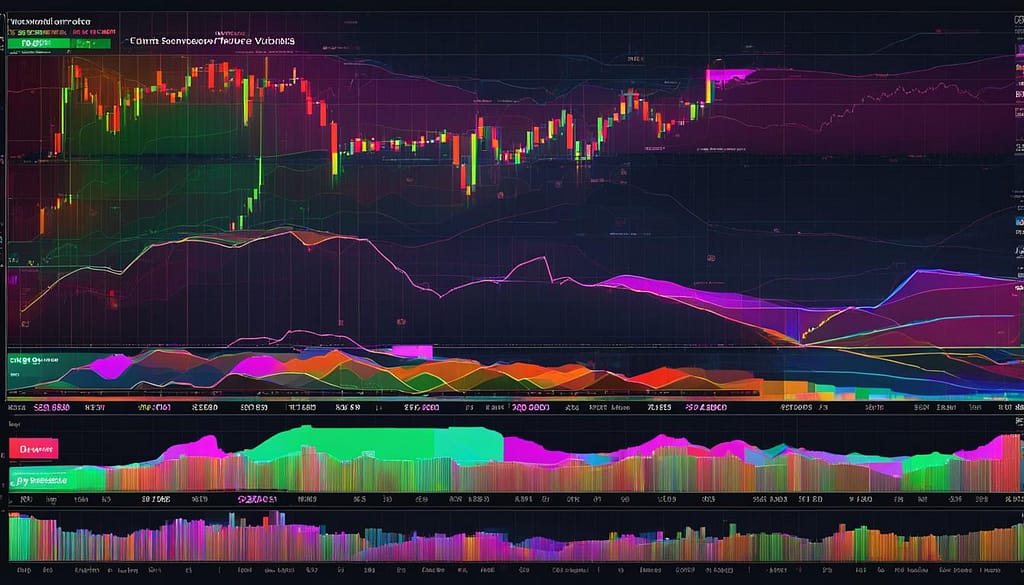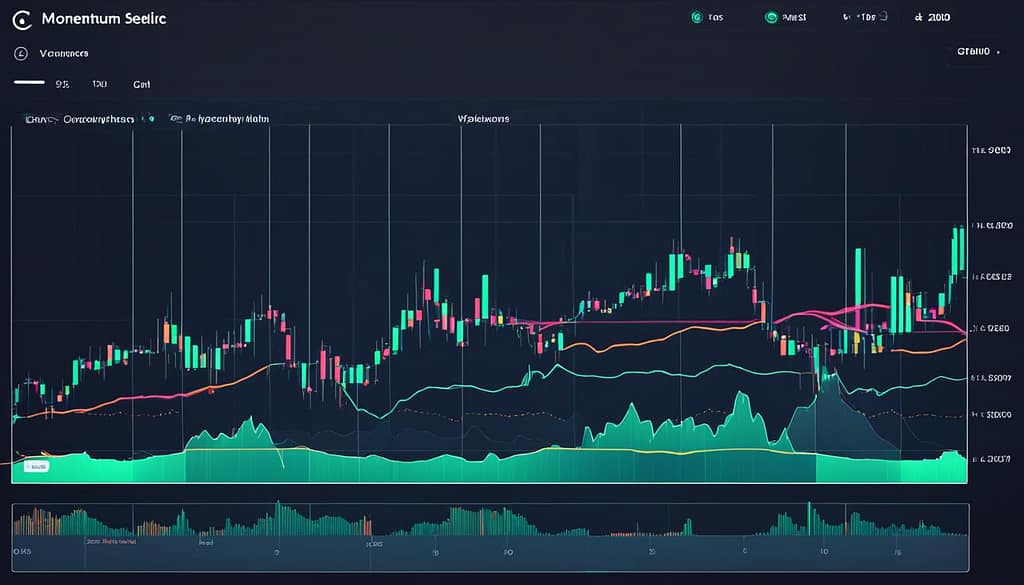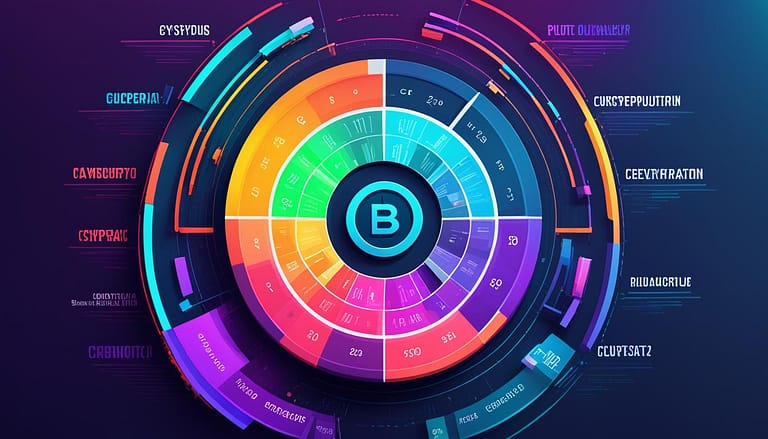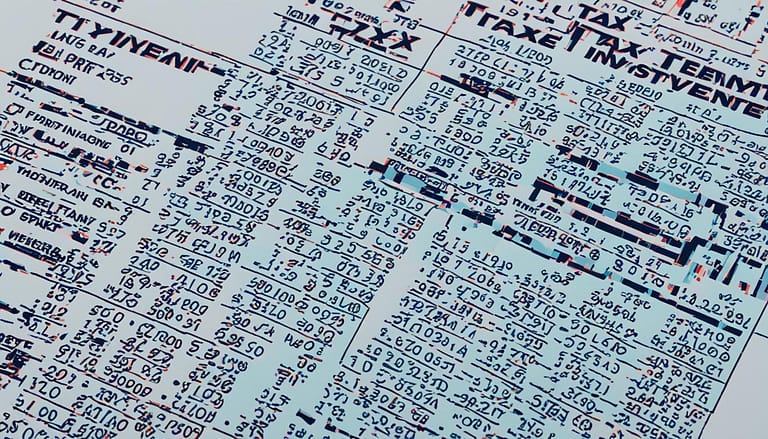Technical Analysis for Cryptocurrency Trading: A Comprehensive Guide
In the dynamic world of digital currencies, Cryptocurrency Technical Analysis has emerged as an essential tool for traders looking to navigate the ebbing waters of market trends. As volatility defines the cryptocurrency market, traders harness historical data to unfold patterns, gauge market sentiments, and strategize their next move. Through meticulous scrutiny of past price and volume fluctuations, traders are equipped with the ability to make predictive analyses of future market behaviours, arming them with the foresight to respond to the often unpredictable cryptocurrency terrain.
Yet, what separates successful traders from the rest is not just the awareness of trading strategies but proficient employment of technical analysis. As a statistically grounded trading strategy, it delves beyond the superficial ebbs and flows to provide a granular understanding of market trends. In this comprehensive guide, you’ll discover how to use these analytical competencies to your advantage, informing your decisions and enhancing your trading tactics within the cryptocurrency domain.
Key Takeaways
- Technical analysis serves as a cornerstone for formulating educated trading conjectures in the volatile cryptocurrency market.
- Understanding historical price and volume data is integral to predicting and capitalizing on potential market movements.
- Recognizing the repetition of market trends enables traders to strategize with greater conviction and foresight.
- Acquisition of technical analysis skills fortifies a trader’s ability to navigate market trends with informed precision.
- Successful application of technical analysis demands an amalgamation of insightful assessment of data and effective trading strategies.
The Essence of Cryptocurrency Technical Analysis
The world of cryptocurrency is dynamic and endlessly evolving, with Cryptocurrency Technical Analysis standing as a cornerstone for trading success. This science and art relies heavily on the meticulous study of market behavior and chart patterns to forecast future price movements. While the markets are inherently unpredictable, technical analysis serves as a competent compass through the often turbulent financial landscapes of digital currencies.
To master the art of Cryptocurrency Technical Analysis, one must delve into the historical depth of market data, including price and volume, as these elements are the bread and butter of any savvy trader. It is the recurrence of patterns and the rhythm of the market that seasoned traders scrutinize, looking for echoes of the past that might resonate with future possibilities.
By recognizing the language of chart patterns, traders gain a vocabulary for predicting and capitalizing on market behavior, taking proactive steps based on quantitative foresight.
Here are the main components that technical analysts focus on:
- **Trend Analysis:** Understanding whether the market is moving up, down, or sideways over various time frames.
- **Chart Patterns:** Identifying shapes and formations that suggest potential market scenarios.
- **Volume Analysis:** Studying trade volume to support or contest a price trend’s legitimacy.
- **Moving Averages:** Using averages to smooth out price action and pinpoint trend direction.
- **Indicators and Oscillators:** Applying tools like RSI or MACD to gauge momentum and market conditions.
With the right set of tools and a keen interpretative eye, technical analysts can glean critical insights into impending market shifts, enabling traders to make informed decisions with greater confidence.
While the principles of technical analysis are well-established, the unique nature of cryptocurrency markets with their volatility and rapid innovation cycle presents both challenges and opportunities. It demands vigilance, adaptability, and an unending willingness to learn and refine one’s analytical approach in the realm of digital currencies.
Historical Price Data: Unlocking Market Movements
Historical price data and cryptocurrency price patterns are crucial for investors seeking to understand and predict market movements. Scrutinizing past pricing information, alongside comprehensive price volume analysis, provides a foundation upon which savvy traders build their forecasts and strategies.
Understanding Price Patterns in Crypto Trading
Price patterns in the crypto universe offer visual narratives of the market’s historical performance and psychological environment. By analyzing formations such as ‘head and shoulders’, ‘double tops’, ‘wedges’, and ‘triangles’, traders can gain invaluable insights into potential price trajectory.
Analyzing Volume and Its Implications on Price
Volume analysis is integral to the authentication of price movements. When price changes are accompanied by significant volume alterations, the reliability of the trend is strengthened, providing traders with confidence in their market predictions.
| Pattern | Description | Implication |
|---|---|---|
| Bullish Engulfing | A smaller red candle followed by a larger green candle | Suggests the onset of a bullish reversal |
| Bearish Engulfing | A smaller green candle followed by a larger red candle | May indicate an approaching bearish downturn |
| Ascending Triangle | Flat top and rising bottom forming a triangle | Predicts continuation of current uptrend |
| Descending Triangle | Flat bottom with decreasing top forming a triangle | Often precedes a downward price breakout |
Chart Patterns and Their Significance
The art of Cryptocurrency Technical Analysis is deeply intertwined with the interpretation of chart patterns. Recognized as the footprints of market sentiment, these patterns provide traders with insights into the psychological interplay between buyers and sellers. By analyzing these visual formations, traders can develop robust trading strategies ideally suited to the volatile realms of cryptocurrency markets.
Chart patterns are not a whimsical aspect of trading analysis; rather, they are a language in themselves, narrating the historical and potential future performance of cryptocurrencies. Amongst the plethora of patterns, a few stand out:
- Head and Shoulders
- Cup and Handle
- Double Tops and Bottoms
- Triangles (symmetrical, ascending, and descending)
- Flags and Pennants
Each pattern speaks volumes about the market dynamics and can signal continuity or change in the trend. Let’s delve into a comparative analysis of the most commonly used charting methods:
| Chart Type | Characteristics | Used for Identifying |
|---|---|---|
| Line Charts | Simplistic, represent closing prices over time | General trend direction |
| Bar Charts | Show price range, open, high, low, close for the period | Price patterns, reversals, continuations |
| Candlestick Charts | Detailed view, embodies price action and sentiment | Market turns, strength of price movement |
Assimilating the data from these charts allows for the extrapolation of possible market scenarios. The line chart offers clarity, bar charts deliver depth, and the candlestick chart presents a scenario ripe for interpretation. When combined with other technical tools, these chart patterns form the cornerstone of an effective trading strategy in the ever-changing cryptocurrency marketplace.
In summary, successful application of chart patterns within Cryptocurrency Technical Analysis requires not just an eye for detail but also a comprehensive understanding of market forces. By recognizing and leveraging these patterns, traders can refine their trading strategies to better forecast and capitalize on potential market movements.
Trading Strategies Rooted in Technical Analysis
Effective trading strategies leverage technical indicators to both forecast market moves and manage risks. The art of timing the market with precision is vital to capitalizing on the ebb and flow of cryptocurrency values while meticulous risk management practices ensure the longevity of one’s trading ventures.
Timing the Market with Technical Indicators
Success in cryptocurrency trading often hinges on the ability to anticipate market shifts. Traders employ a multitude of technical indicators to shape their market entry and exit decisions. For instance, the use of trend lines can highlight ongoing market directions, whereas momentum-based indicators like the Relative Strength Index (RSI) help traders gauge whether assets are overbought or oversold. Moreover, Bollinger Bands provide insights into market volatility and potential price breakout points.
Trade Management and Risk Assessment Techniques
In the realm of cryptocurrency trading, managing trades and assessing risks are two sides of the same coin. A trader’s skill in employing methods of risk controls can define the success ratio of their trading outcomes. Through the adoption of stop-loss orders, position sizing, and diversification strategies, traders can mitigate potential losses and preserve capital even during volatile market conditions.
| Technical Indicator | Use-case | Objective |
|---|---|---|
| Relative Strength Index (RSI) | Identifying Overbought/Oversold Conditions | Timing the Market for Optimal Entry/Exit Points |
| Trend Lines | Observing Direction of Price Movement | Confirming the Strength of Market Trends |
| Bollinger Bands | Assessing Market Volatility | Spotting Breakouts and Trend Reversals |
It’s evident that the rigorous application of technical indicators and risk assessment approaches form the backbone of strategized trading in the cryptocurrency markets. By understanding and integrating these tools, traders set themselves apart, harnessing the dynamic nature of the digital assets to their advantage.
Utilizing Trend Lines for Predictive Insight
Trend lines stand as one of the most essential elements in technical analysis, serving as a visual compass to decipher market movements. By connecting a series of historical price points, trend lines provide a graphical representation of both support and resistance levels, painting a narrative of market sentiment. Whether illustrating a bullish ascent or a bearish descent, the ability to read these lines offers traders a predictive insight that is invaluable to making astute trading decisions.
As a strategic tool, trend lines give substance to the abstract movements of the market, enabling traders to foresee potential price pivots and trend continuations. It is essential to approach these trend lines with a critical eye, understanding that while they plot the past, they also cast a shadow into the future of the markets.
Let’s demystify the concept of trend lines by breaking down key types:
- Uptrend Line: Constructed by connecting the lowest points of the price chart, indicating support levels where prices find upward momentum.
- Downtrend Line: Formed by linking the highest points, highlighting resistance levels where prices could potentially face downward pressure.
- Horizontal Trend Line: Often referred to as a sideways trend, indicates a range where the asset moves between consistent high and low points.
These visually inferred guides serve as critical junctures influencing trading strategies across the board. Delve into the table below to see a comparative overview of how trend lines signal market behavior:
| Trend Line Type | Market Sentiment | Implication for Traders |
|---|---|---|
| Uptrend Line | Bullish | A signal to consider long positions as market appears to ascend |
| Downtrend Line | Bearish | Indicates potential for short-selling or exiting long positions |
| Horizontal Trend Line | Neutral | Demonstrates a consolidation phase, can precede a breakout or breakdown |
The application of trend lines within technical analysis extends beyond mere prediction; it is about the elucidation of patterns that dictate market tides. Trading strategies harness these insights, aligning investments with the trajectory forecasted by historical trends.
Moving Averages and Their Impact on Trading Decisions
When considering the multitude of analysis tools at the disposal of a cryptocurrency trader, moving averages stand out for their ability to filter market “noise” and offer a clearer view of price trends. These time-tested indicators serve as a backbone for market analysis and can significantly influence trading decisions.
Moving averages generally come in two forms: the Simple Moving Average (SMA) and the Exponential Moving Average (EMA). The SMA is calculated by averaging the price of an asset over a specific number of days, while the EMA gives more weight to recent prices, making it more sensitive to new market information.
- SMA: Ideal for identifying long-term trend patterns and smoothing out price data over a given period.
- EMA: Better for responding to recent price changes, hence often preferred for short- to mid-term trading strategies.
One of the critical applications of moving averages in trading is the detection of crossovers. A crossover occurs when a shorter-term moving average crosses over a longer-term moving average. For example:
A bullish crossover is observed when a short-term EMA, such as the 10-day EMA, crosses above a longer-term SMA, such as the 50-day SMA. This is typically viewed as a buying signal.
Conversely:
A bearish crossover happens when a short-term EMA crosses below a long-term SMA, which may prompt traders to consider selling off their positions.
While moving averages can greatly aid in refining trading strategies, it’s essential for traders to use them as part of a broader market analysis, considering other potential indicators and market conditions to avoid false signals.
Ultimately, by integrating moving averages with additional market indicators and fundamental analysis, traders can enhance their ability to make more informed and effective trading decisions.
The Relevance of Support and Resistance Levels
Understanding the concept of support and resistance levels is fundamental to mastering cryptocurrency trading dynamics. These are not just abstract terms but influential points that convey the psychological sentiment of the market participants. Recognizing these levels can be instrumental in developing profitable trading strategies for both short-term and long-term investment horizons.
Identifying Profitable Entry and Exit Points
The ability to identify support and resistance levels gives traders an advantageous perspective on when to enter and exit the market. Support levels, often perceived as the floor of the market price, suggest areas where demand is sufficiently strong to prevent the price from declining further. Conversely, resistance levels are seen as the ceiling, limiting the potential for price hikes. These levels can serve as signals for traders to capitalize on price fluctuations, thereby enabling more profitable trading decisions.
How Support and Resistance Shape Market Psychology
Market psychology is heavily influenced by the collective actions and reactions of traders around support and resistance levels. When a cryptocurrency’s price approaches these levels, traders often anticipate a response from the market, either a rebound from the support level or a retraction at the resistance. This anticipation drives a generally cautious or assertive behaviour, which then translates into impactful market movements. In essence, these thresholds can become self-fulfilling prophecies as traders align their actions with the expectations set by support and resistance levels.
Momentum Indicators and Their Role in Crypto Trading
Momentum indicators are instrumental for traders in the dynamic world of cryptocurrency trading. These tools provide a graphical representation of the speed and magnitude of price movements, helping investors to discern whether a cryptocurrency is entering overbought or oversold territories. Two widely-recognized momentum indicators that have become the bedrock of many trading strategies are the Relative Strength Index (RSI) and the Moving Average Convergence Divergence (MACD).
The RSI is a bounded oscillator that measures the speed and change of price movements within a range of zero to 100. Traditionally, an RSI reading above 70 indicates that an asset may be overbought, while a reading below 30 suggests that it might be oversold. On the other hand, the MACD tracks the relationship between two moving averages of an asset’s price. Traders watch for the MACD line to cross above or below a signal line to identify potential buy or sell signals.
| Indicator | Type | Key Function | Common Usage |
|---|---|---|---|
| RSI (Relative Strength Index) | Oscillator | Identify Overbought/Oversold Conditions | Determining potential reversal points |
| MACD (Moving Average Convergence Divergence) | Trend-Following Momentum | Signal Trend Changes and Momentum | Signaling buying or selling opportunities |
By integrating these momentum indicators into their trading arsenal, investors can develop a nuanced approach to market entry and exit decisions. However, it’s paramount for traders to remember that these tools should not be used in isolation. For enhanced accuracy, they are best combined with other technical analyses and market sentiment indicators.
Relative Strength Index (RSI) and Moving Average Convergence Divergence (MACD) are cornerstones of technical analysis in cryptocurrency trading, offering unique perspectives on market momentum and potential shifts in trend direction.
An astute trader knows that the key to harnessing the power of these indicators lies in their ability to detect early signs of momentum change, prefiguring potential trend reversals in the competitive marketplace.
Volume Analysis: A Key to Understanding Market Strength
In the realm of cryptocurrency trading, volume analysis is akin to a vital sign indicating the vigor of the market. By effectively decoding volume patterns, traders can ascertain the market strength that underpins price movements. This analysis extends far beyond mere observation of price fluctuations; it involves a strategic understanding of market dynamics through the lens of trading activity.
When prices advance or decline with substantial trading volumes, the movement is generally perceived as being robust. In contrast, a price change on thin volume might suggest a lack of conviction, potentially signaling an imminent reversal. This knowledge is paramount for traders seeking to capitalize on momentum or safeguard investments from unforeseen volatility. Let’s examine a comparative analysis to contextualize the significance of volume in cryptocurrency markets:
| Price Trend | Volume Observation | Market Interpretation |
|---|---|---|
| Uptrend | Increasing Volume | Strong Bullish Sentiment |
| Uptrend | Decreasing Volume | Potential Bullish Exhaustion |
| Downtrend | Increasing Volume | Strong Bearish Sentiment |
| Downtrend | Decreasing Volume | Potential Bearish Weakness |
Understanding such nuances in volume analysis aligns a trader’s strategy with the true pulse of the market, enabling decisions that are in harmony with the collective market sentiment. It is this deep comprehension of market narratives that empowers traders to tackle the formidable waves of cryptocurrency markets with confidence and strategic foresight.
Integrating Bollinger Bands into Your Trading Strategy
One of the most effective ways to navigate the intricacies of market volatility is through the application of Bollinger Bands within your trading strategy. These dynamic bands serve not only as a measure of market volatility, but they are also instrumental in revealing market dynamics that could lead to significant profit opportunities.
Determining Market Volatility with Bollinger Bands
Understanding market volatility is fundamental for traders, and Bollinger Bands offer a straightforward approach to gauge this ever-changing element. With standard settings, the bands consist of a middle SMA line and two outer lines representing standard deviations from the middle line. A visually tighter ‘squeeze’ of the bands signals a period of low market volatility, often observed before a market breakout.
Utilizing Bollinger Bands for Breakout Strategies
Traders looking for breakout signals frequently turn to Bollinger Bands for insights. A break above the upper band or below the lower band might be seen as an initiation of a new trend. Additionally, the bands serve as excellent guides in setting stop-loss points or taking profit, as they reflect the underlying price volatility and help manage risks.
By incorporating Bollinger Bands into a cryptocurrency trading strategy, you embrace a quantified approach towards deciphering market volatility. The practical application of these bands extends beyond the mere identification of market phases to include robust signals for entry and exit points in trading scenarios.
Benefits and Risks of Cryptocurrency Technical Analysis
The application of technical analysis in cryptocurrency trading provides traders the opportunity to gain a strategic advantage by deciphering market patterns and timing their trades with precision. One of the primary benefits of technical analysis is its ability to transform complex market data into actionable insights, potentially leading to more informed and lucrative trading decisions. Objective and data-driven, this method relies on quantifiable historical market performance to predict future price movements.
However, traders must understand the risks alongside the benefits to effectively navigate the volatile cryptocurrency markets. A glaring concern is the possibility of false signals that can lead to misinterpretation of market directions. Additionally, technical analysis may inadvertently downplay the impact of fundamental market events, such as regulatory changes or significant technological advancements in blockchain, which can trigger rapid and unexpected price fluctuations. Therefore, a fusion of technical analysis with an acute awareness of global market events and trends is essential for attaining balanced trading outcomes.
| Advantages of Technical Analysis | Potential Risks and Limitations |
|---|---|
| Objective evaluation based on historical data | Risk of interpreting false signals as accurate indicators |
| Identification of trends and potential reversal points, aiding in optimal trade timing | Over-reliance can lead to ignorance of fundamental market forces |
| Utilization of various indicators to anticipate price movements | Historical data does not guarantee future market behaviour |
| Risk management through precise entry and exit strategies | Market volatility and unpredictability can diminish analysis coherence |
Incorporating cryptocurrency trading strategies that are backed by technical analysis can enhance efficiency and profitability while keeping a tab on the risks involved. Mastery of technical tools, combined with vigilant market surveillance, works to mitigate the drawbacks inherent in a purely statistical approach. Ultimately, achieving a balance between these aspects can empower traders to leverage the volatile crypto terrain for successes that are not only momentary but also sustainable over the long term.
Conclusion
Embarking on a journey through the complexities of Cryptocurrency Technical Analysis unveils a robust framework for traders seeking to interpret the ebbs and flows of an often unpredictable market. The strategic examination of historical price and volume data not only equips traders with a deeper understanding of market trends but also fortifies their decision-making process; it’s the crucible within which informed trading is refined.
Our foray into the myriad analytical tools has underscored the value of pattern recognition, volume measurement, and the countless indicators essential to navigating the cryptocurrency domain. Precision in trading is not an elusive goal, but rather a tangible outcome of meticulous market analysis—a testament to the efficacy of technical analysis in yielding actionable market insight.
However, as potent as these techniques are, undeniably, they are not absolute. Their potency must be tempered with an awareness of broader economic indicators and world events. Traders who seek long-term success do not view technical analysis in isolation but integrate it into a holistic strategy, one that acknowledges both its strengths and intrinsic risks. In essence, successful crypto trading resides not just in charts and numbers but in a balanced interplay of analysis, instinct, and continual learning.










